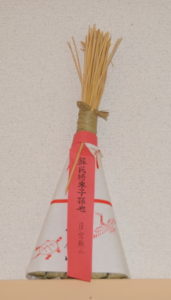It is almost time for the highlight of this year’s Gion Matsuri – the main saki parade will be on July 17. Yesterday, today, and tomorrow night are the yoiyama, the nights preceding the festival which means essentially a huge party in the inner city of Kyoto. Not only are people celebrating summer, they also visit the floats that will be shown in the parade on Tuesday to buy souvenirs.
 And one of those souvenirs are chimaki. “Souvenir” is actually not correct, chimaki are protective charms made from bamboo leaves. People put them up at the entrance of their homes or businesses to ward off evil and to prevent sickness. But only for one year – you’ll have to buy a new one at the next Gion Matsuri!
And one of those souvenirs are chimaki. “Souvenir” is actually not correct, chimaki are protective charms made from bamboo leaves. People put them up at the entrance of their homes or businesses to ward off evil and to prevent sickness. But only for one year – you’ll have to buy a new one at the next Gion Matsuri!
Traditionally, chimaki were thrown from the large hoko floats into the gathered crowds, but nowadays, they are sold during the days (and nights) of the yoiyama. Every float has their own chimaki, with slightly different properties, but the chimaki of the Naginata hoko, which always leads the saki parade, is considered the most powerful and thus extremely popular among the locals.
The story behind the chimaki is ancient and it goes like this: A long, long time ago, the god Susanoo (the brother of the sun goddess) was travelling in disguise through Japan. One evening, he looked for shelter, but was refused entry to all of the wealthy houses of the town. But when he knocked at poor Somin Shorai’s home, he was welcomed and treated with great respect. When Susanoo left the next day, he gave Somin Shorai a bundle of cogon grass to wear at his waist for protection, which was the origin of today’s chimaki. (*) To this day, some chimaki have an extra red strip of paper attached saying “I am a descendant of Somin Shorai”, which is believed to offer extra protection against evil.
(*) Other versions of the story say he received a small wreath of miscanthus reeds, the origin of today’s chinowa wreath, which is used in the Nagoshi no Harae summer purification.
It seems that these kind of chimaki are a speciality of Kyoto or Gion Matsuri in particular. This may be because Susanoo is the main god enshrined at Yasaka Shrine, for which Gion Matsuri is held. When researching this topic, most of the websites about chimaki pointed to a type of sweet rice dumpling wrapped in bamboo leaves, that are eaten at Boy’s Day in May. But that’s a topic for another weekend post.
PS: I cannot for the heck of it find the photos of my own chimaki at the moment. It’s too late to take new ones, so I’ll add them tomorrow. Thanks for your patience!
